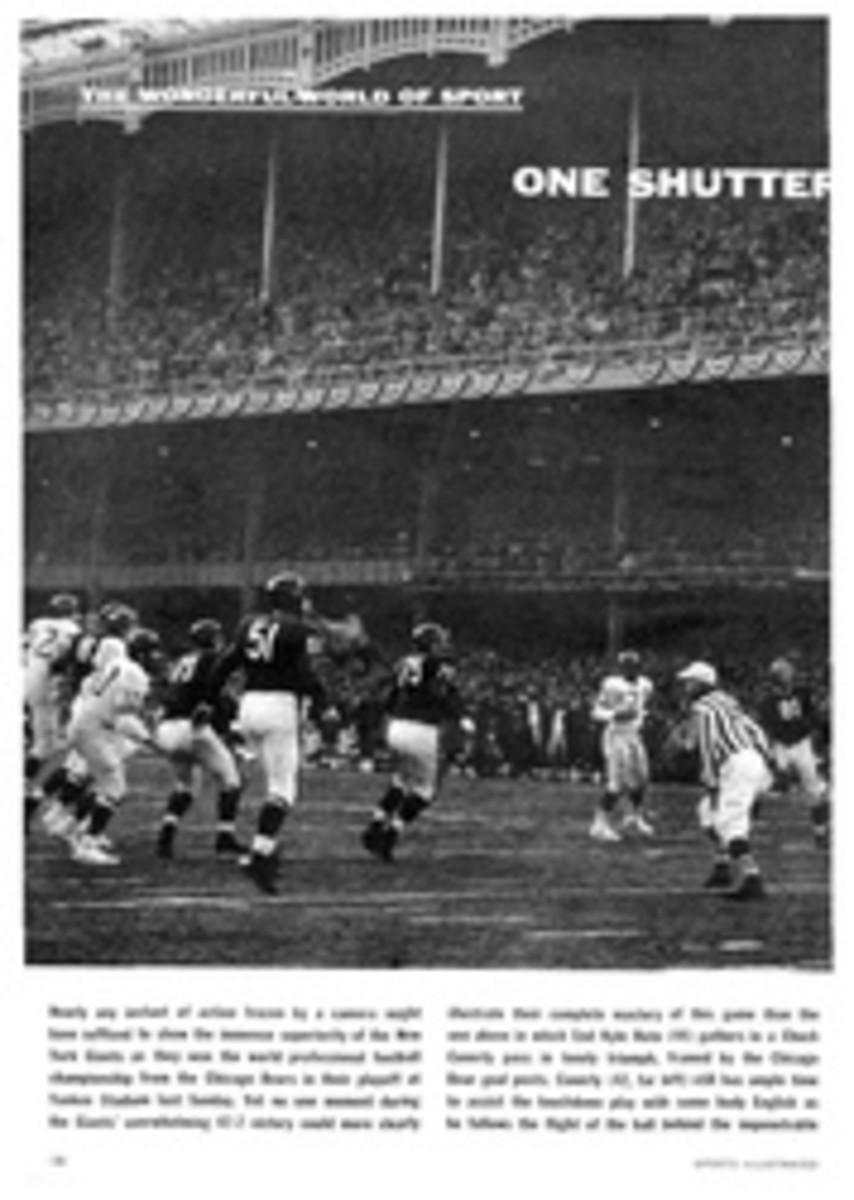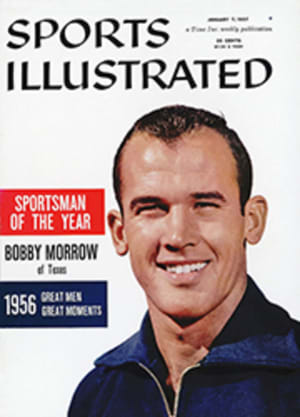
NOTES ON A GELID AFTERNOON
When the goal posts went down before the rush of delirious New York fans, the scoreboard read, incredibly, "Giants 47 Bears 7." On the frozen, marblelike surface of Yankee Stadium the players shuffled doggedly through the mob—the Giants grinning at well-wishers, the Bears pushing quietly, sullenly through the gloating Giant rooters.
For more than two hours of this gelid December afternoon the New York Giants played football with the savage precision of true professionals. Chuck Conerly, the old pro (SI, Dec. 3) who directs the Giant offense, loosed his aerial salvos with meticulous aim; the thunderous Giant runners moved with sure-footed power over this slippery field. The Giant lines—both offensive and defensive—administered a thorough cuffing to the opposing Bear units, and the Giant secondary defense, which had given away two late and tying touchdowns in a regular season game between these same teams, leaked not at all with the world championship in the balance.
Against a team so well equipped and so well prepared, the Bears never really had a chance. They had a reason for the dimension of their defeat, although it was not revealed until after the game—and so is as suspect as any afterthought.
Ed Brown, the Bear quarterback, said it first.
"We were overtrained," he said. "We only had one day off—Christmas Day—preparing for this. What the hell—the Giants got five days off. We were just too tied up."
Another reason for the size of the defeat might have been the Bears' shoes. The Giants wore fiat-soled basketball shoes throughout the game and had very little trouble getting traction on the icy field. The Bears tried rubber-soled shoes with short cleats during the first half, changing to flat soles in the second. They had trouble with the cleats, slipping and sliding, and the Giant line moved the Bears as if they were on roller skates.
But the first cause of the Giant victory was the superb team effort of all 33 Giants. This team would have beaten the Bears on any kind of field in any type of shoe.
The Bears had no valid answer to the running of Frank Gifford and Mel Triplett and Alex Webster. The Giant blockers were pounding wide holes in the Bear line and these backs—all of whom run with what pro coaches call sock—just wouldn't give way to the arm tackles of the Chicago linebackers. The passing patterns of the Giants took every advantage of the Bears' sluggish shortcomings, so that Old Pro Conerly, using his ends as decoys, found his halfbacks constantly available for his sharpshooting. On one occasion Gifford went down on a pattern which sends him to the sideline and improvised brilliantly when he found his route blocked, broke into the clear 10 yards behind the Bear defender. The play covered 66 yards, setting up the fifth Giant touchdown. Another time Don Heinrich, who quarterbacked the first quarter for the Giants, changed his call at the line of scrimmage to send Triplett busting 17 yards through a flaw in the Bear defense for the first touchdown.
Harlon Hill, the incomparable Bear end, and Rick Casares, the Bears' league-leading ground gainer, were useless against an inspired Giant defense. Sam Huff, rookie linebacker from West Virginia, dogged Casares all afternoon, keying on the dangerous fullback with each Bear play.
"Those linebackers were terrific," said Hill. "No matter which way I turned, there was a linebacker on me. They were better than us. That's all."
PHOTO
FOOTWEAR was a major strategy on the frozen field. Bears chose ineffectual rubber-cleated shoes, Giants adhesive flat soles. Giant Gifford (16) escapes Bears' Smith (20), proving home team's wisdom.
PHOTO
USUALLY BLASE NEW YORK FANS, OVERCOME WITH COLLEGIATE ENTHUSIASM FOR THEIR CHAMPION GIANTS, MAKE OFF WITH GOAL POSTS

